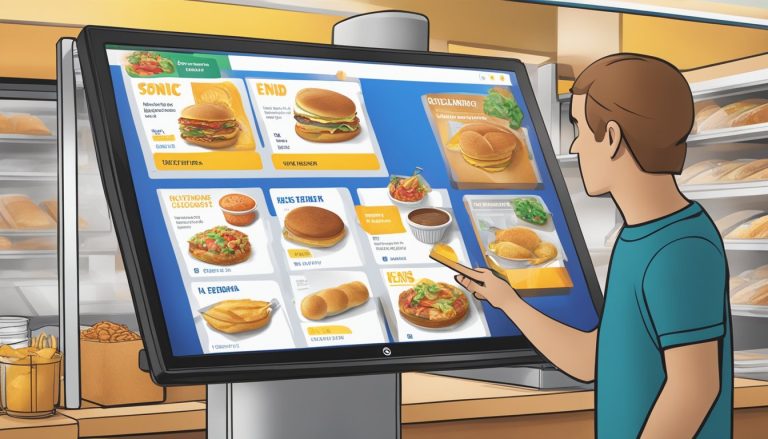Sonic Drive-In, a beloved American fast-food chain, serves millions of breakfast items to customers each year. Behind the scenes, an intricate supply chain ensures that fresh ingredients reach every location to create those delicious Breakfast Burritos and Breakfast Toaster sandwiches.
Sonic purchases 155 million eggs annually to meet the demand for its popular breakfast menu items. This staggering number highlights the scale of Sonic’s breakfast operations and the complexity of its supply chain management. The company’s commitment to sourcing responsibly has led to a significant shift in its egg procurement practices.
In response to evolving customer preferences, Sonic has announced plans to transition to 100% cage-free eggs by 2025. This move demonstrates the company’s adaptability and willingness to align its supply chain with consumer values. As Sonic continues to innovate and improve its logistics, customers can expect their favorite breakfast items to be made with sustainably sourced ingredients.
Sonic’s Position in the Fast-Food Landscape

Sonic Drive-In occupies a unique niche in the competitive fast-food industry with its nostalgic drive-in model and diverse menu offerings. The company has grown from a small Oklahoma-based chain to a major national player through strategic expansion and franchising.
History and Growth of Sonic Drive-In
Sonic Drive-In was founded in 1953 in Shawnee, Oklahoma. Originally named Top Hat Drive-In, it rebranded to Sonic in 1959. The company expanded rapidly through franchising in the 1960s and 1970s.
By the 1990s, Sonic had become a regional powerhouse in the South and Midwest. Under CEO Cliff Hudson’s leadership, the chain experienced significant growth, reaching 3,500 locations by the mid-2010s.
Sonic’s expansion strategy focused on suburban and rural areas, where its drive-in model thrived. The company’s ability to adapt to changing consumer preferences while maintaining its core identity contributed to its success.
Sonic’s Unique Drive-In Model
Sonic’s drive-in format sets it apart from traditional fast-food restaurants. Customers park in individual stalls and place orders via intercom. Carhops, often on roller skates, deliver food directly to vehicles.
This nostalgic approach appeals to customers seeking a unique dining experience. The drive-in model allows for a wider menu variety compared to typical fast-food chains, as food is prepared to order.
Sonic’s menu features American fare with a twist, including burgers, hot dogs, and an extensive drink selection. The company’s ability to offer customizable options and seasonal specials has helped maintain customer interest.
Breakfast Menu Curation

Sonic’s breakfast menu offers a diverse array of options, from hearty burritos to sweet French toast sticks. The chain carefully balances flavor, convenience, and nutritional considerations in its breakfast lineup.
Development of Sonic’s Breakfast Offerings
Sonic has continuously evolved its breakfast menu to meet changing customer preferences. The chain introduced its breakfast offerings in 2001, focusing on portable items suitable for on-the-go consumption.
Over the years, Sonic expanded its morning selection to include popular choices like the SuperSONIC Breakfast Burrito and French Toast Sticks. These items quickly became fan favorites due to their taste and convenience.
Sonic’s commitment to innovation led to the creation of unique offerings such as the Breakfast Toaster, combining savory ingredients on Texas toast. The chain also embraced the All-Day Breakfast trend, allowing customers to enjoy morning favorites at any time.
Breakfast Toaster Sandwich and Burrito Varieties
Sonic’s breakfast menu features a range of toaster sandwiches and burritos to cater to diverse tastes. The Breakfast Toaster lineup includes options with bacon, sausage, or ham, paired with eggs and cheese on Texas toast.
The burrito selection is equally varied:
- SuperSONIC Breakfast Burrito: Filled with sausage, eggs, tater tots, cheese, tomatoes, onions, and jalapeños
- Breakfast Burrito: A simpler version with eggs, cheese, and choice of meat
- Ultimate Meat & Cheese Breakfast Burrito: Packed with bacon, sausage, and ham
These options provide customers with choices ranging from classic flavors to more indulgent combinations, ensuring broad appeal.
Health Considerations and Calorie Counts
While Sonic’s breakfast menu emphasizes flavor and satisfaction, the chain also considers health-conscious customers. Nutritional information is readily available, allowing diners to make informed choices.
Calorie counts vary widely across the menu:
- French Toast Sticks (4 piece): 260 calories
- Breakfast Burrito: 500-600 calories, depending on meat choice
- SuperSONIC Breakfast Burrito: 640 calories
Sonic offers some lighter options, such as the Jr. Breakfast Burrito, with fewer calories for those watching their intake. The chain also provides customization options, allowing customers to adjust ingredients to better suit their dietary needs.
Supply Chain Management
Sonic’s breakfast supply chain relies on efficient management to deliver fresh, high-quality meals to customers. This involves strategic supplier partnerships, streamlined distribution, and innovative production processes.
Supplier Selection and Collaboration
Sonic carefully selects suppliers based on quality, reliability, and cost-effectiveness. The company collaborates closely with food and beverage providers to ensure consistent ingredient standards. Sonic’s digital supply chain technology enables real-time communication with suppliers, allowing for quick adjustments to inventory levels and order quantities.
Long-term partnerships are established with key suppliers to secure stable pricing and priority access to ingredients. Regular quality audits and performance reviews help maintain high standards across the supply network.
Logistics of Food and Drink Distribution
Efficient distribution is crucial for Sonic’s breakfast offerings. The company utilizes a network of regional distribution centers to manage inventory and reduce transportation times. Temperature-controlled trucks ensure food safety and quality during transit.
Advanced routing software optimizes delivery schedules, minimizing fuel consumption and ensuring timely restocking of restaurant locations. Sonic employs a just-in-time inventory system to reduce waste and maintain ingredient freshness.
Real-time tracking allows for precise monitoring of shipments and proactive problem-solving in case of delays.
Prototyping and Volume Production
Sonic’s product development team works closely with suppliers to prototype new breakfast items. Small-scale production runs allow for taste testing and quality assurance before full rollout.
Once approved, recipes are standardized for volume production. Sonic’s automated production lines ensure consistency across all locations. Digital systems track ingredient usage and production rates, enabling quick adjustments to meet demand fluctuations.
Sonic continuously refines its production processes to improve efficiency and reduce costs without compromising quality. Regular staff training ensures proper preparation techniques are maintained across all restaurants.
Manufacturing and Technology Integration

Sonic Manufacturing Technologies leverages advanced digital systems to streamline breakfast production. Their innovative approach integrates APIs, electronic manufacturing services, and IoT devices to optimize the supply chain.
Sonic Manufacturing Technologies
Sonic Manufacturing Technologies employs a digital supply chain to automate processes from start to finish. Their system uploads engineering data to an ERP business system, enabling rapid decision-making. This technology handles up to 75% of the one million parts per week entering the factory.
The company uses a system called HAL to monitor data accuracy. HAL fixes mistakes, updates records, and alerts staff when action is needed. This automation allows Sonic to operate efficiently at scale.
APIs and Electronic Manufacturing Services
APIs play a crucial role in Sonic’s manufacturing ecosystem. They enable seamless communication between different systems and partners in the supply chain.
Electronic Manufacturing Services (EMS) providers use these APIs to integrate directly with Sonic’s systems. This integration allows for:
- Real-time inventory updates
- Automated order processing
- Instant quality control feedback
By leveraging APIs, Sonic reduces delays and improves coordination across its breakfast supply chain.
The Role of IoT in Supply Chain Efficiency
IoT devices are key to Sonic’s supply chain efficiency. Smart sensors monitor ingredient freshness and equipment performance in real-time. This data feeds into Sonic’s central systems, enabling proactive maintenance and quality control.
IoT-enabled tracking systems provide visibility into shipment locations and conditions. This allows Sonic to:
- Optimize routing
- Reduce food waste
- Ensure ingredients arrive at peak freshness
Temperature sensors in transport vehicles and storage facilities help maintain food safety standards. The integration of IoT technology enhances Sonic’s ability to deliver consistent, high-quality breakfast items to customers.
Customer Experience and Satisfaction

Sonic’s unique drive-in model and focus on personalized service contribute significantly to customer satisfaction. The company’s approach combines traditional elements with modern conveniences to create a distinctive dining experience.
The Role of Carhops and Customer Service
Sonic’s carhops play a crucial role in shaping customer experience. These employees, often on roller skates, deliver food directly to customers’ vehicles. This personal touch creates a nostalgic atmosphere while providing efficient service. Carhops are trained to be friendly and attentive, enhancing the overall dining experience.
Sonic emphasizes speed and accuracy in order fulfillment. The company utilizes technology to streamline the ordering process, allowing customers to place orders via touchscreen menus or mobile apps. This integration of technology with personal service helps reduce wait times and minimize errors.
Customer feedback is actively sought and addressed. Sonic regularly conducts surveys and monitors social media to gauge satisfaction levels and identify areas for improvement.
Customization Options and Menu Variety
Sonic offers extensive customization options, allowing customers to tailor their meals to their preferences. The menu features a wide array of items, from burgers and hot dogs to ice cream and slushes. This variety caters to different tastes and dietary needs.
Customers can modify ingredients, portion sizes, and even create unique flavor combinations for drinks. The ability to mix and match toppings and sauces gives patrons a sense of control over their meal.
Sonic regularly introduces limited-time offers and seasonal items. These promotions keep the menu fresh and exciting, encouraging repeat visits and fostering customer loyalty.
Implications of All-Day Breakfast Availability
Sonic’s all-day breakfast availability significantly impacts customer satisfaction. This policy caters to diverse schedules and preferences, allowing patrons to enjoy breakfast items at any time. The flexibility appeals to shift workers, late risers, and breakfast enthusiasts.
The all-day breakfast menu includes popular items like breakfast burritos, French toast sticks, and breakfast sandwiches. This variety ensures that customers have multiple options regardless of when they visit.
Offering breakfast throughout the day presents operational challenges. Sonic has optimized its kitchen processes to handle the simultaneous preparation of breakfast and regular menu items efficiently. This streamlined approach helps maintain food quality and service speed during peak hours.
Marketing Strategies and Sales Initiatives

Sonic Drive-In employs a diverse range of marketing tactics and sales initiatives to attract customers and drive growth. The company leverages its unique drive-in format and menu offerings to differentiate itself in the competitive fast-food landscape.
Happy Hour and Promotional Deals
Sonic’s Happy Hour is a cornerstone of its marketing strategy. Offering half-price drinks and slushes daily from 2-4 PM, this promotion drives significant afternoon traffic. The company also runs seasonal promotions, such as $0.50 corn dogs on select days.
Limited-time menu items create buzz and urgency. Sonic frequently introduces new flavor combinations for its drinks and ice cream treats. These special offerings are heavily promoted through TV commercials, social media, and in-app notifications.
Digital coupons and app-exclusive deals incentivize customers to use Sonic’s mobile ordering platform. This strategy helps build customer loyalty and gather valuable data on purchasing habits.
Targeted Sales Mix and Dayparts
Sonic tailors its menu and promotions to specific dayparts, maximizing sales throughout the day. The breakfast menu, available all day, appeals to both early risers and late-night snackers.
The company focuses on high-margin items like drinks and ice cream. These products have lower food costs and higher profitability. Combo meals encourage customers to add sides and drinks to their orders, increasing average check sizes.
Sonic’s extensive customization options cater to diverse tastes. This flexibility allows the chain to target various demographic groups and dietary preferences.
Competitive Strategy in Fast-Casual Segment
Sonic positions itself as a hybrid between fast-food and fast-casual dining. The drive-in format offers quick service with a unique, retro-inspired experience.
Menu innovation keeps Sonic competitive. The chain regularly introduces new items that blend familiar flavors with unexpected twists. This approach helps Sonic stand out in a crowded market.
Sonic emphasizes its made-to-order food preparation, aligning with fast-casual quality expectations. The company highlights fresh ingredients and customization options to appeal to health-conscious consumers.
Strategic partnerships, such as collaborations with popular brands or local sports teams, help Sonic tap into new customer bases and create buzz-worthy promotions.
Future of Sonic’s Breakfast Offering

Sonic’s breakfast menu is poised for evolution, with new items, technology, and expansion strategies on the horizon. The chain aims to solidify its position as a breakfast destination while adapting to changing consumer preferences.
Innovations in Breakfast Menu Items
Sonic plans to introduce new breakfast sandwiches that blend traditional favorites with unexpected flavors. The chain is exploring plant-based options to cater to health-conscious customers. Protein-packed breakfast bowls featuring ingredients like quinoa and avocado are in development.
Sonic’s R&D team is experimenting with unique breakfast hot dogs, combining breakfast meats and toppings on their signature buns. New grab-and-go items will target busy commuters seeking portable morning meals.
Potential for Technology Advancements
Sonic is investing in AI-powered ordering systems to enhance accuracy and speed. The company is developing a mobile app update with personalized breakfast recommendations based on past orders.
Digital menu boards will allow for real-time updates and dynamic pricing. Sonic is testing automated cooking equipment to streamline breakfast preparation. The chain plans to implement IoT sensors for inventory management, ensuring fresh ingredients for morning customers.
Expansion and Scaling Strategies
Sonic aims to increase its breakfast market share by extending morning hours at select locations. The company is exploring partnerships with delivery platforms to reach more breakfast customers.
Sonic plans to open smaller format stores in urban areas, focusing on breakfast and lunch crowds. The chain is considering 24-hour breakfast options at high-traffic locations near colleges and entertainment districts.
To support growth, Sonic is upgrading its supply chain with regional distribution centers. The company is also investing in employee training programs to maintain consistent breakfast quality across all locations.




